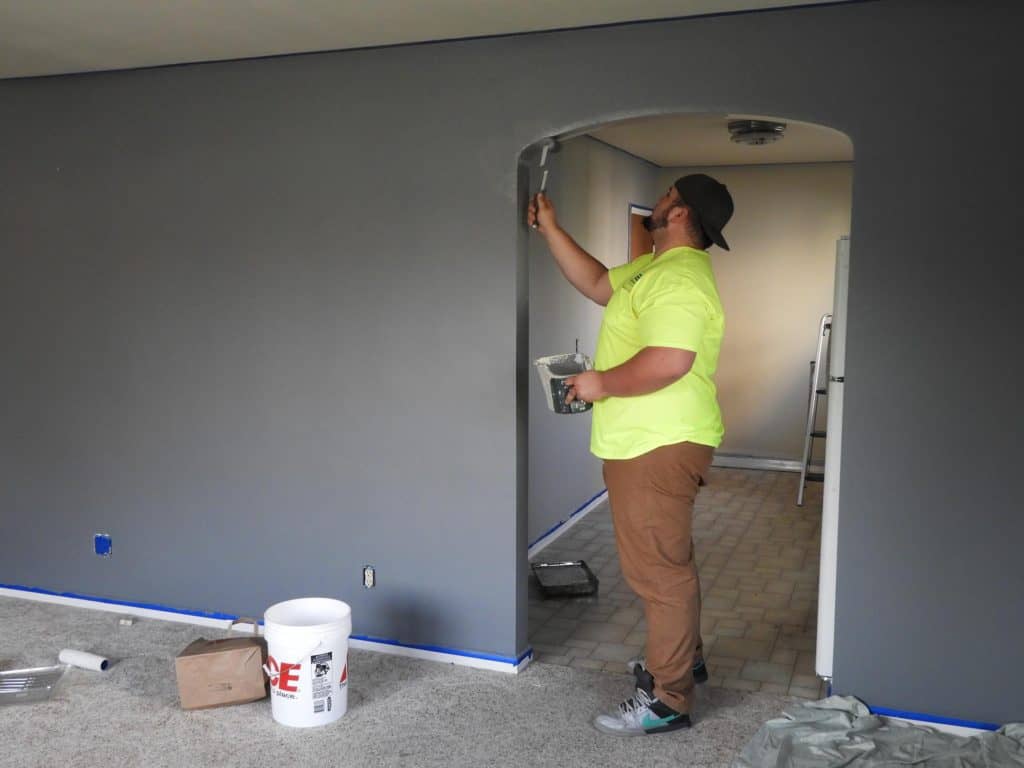Painting your home can take quite a bit of time when you consider the prep work, waiting for the paint to dry, a second coat, more dry time, and then waiting for the fumes to dissipate before you can resume living in the room again. People are always looking for a way to speed up the process whether it’s storing your brushes in plastic to minimize clean up or ways to make paint dry faster, but what about ways to get rid of paint fumes more quickly?
Getting rid of paint smell can be done effectively by making sure the room is well ventilated, using baking soda to help absorb the smell, and using an air purifier to help rid the air of those strong fumes. There are, of course, a lot of ways to mask the paint smell, but the fumes are what can be harmful to some people. These methods can rid the room of paint fumes much quicker than if the room is left to sit with no airflow.

How to get rid of paint smell
- Ventilation – It is very important that you keep the room well ventilated throughout the painting process. If possible, open the windows and turn on the ceiling fan to help dissipate the paint fumes. You can also bring in fans to place around the room to increase airflow, which will also help with dry time. If there is a window in the room, it’s a good idea to place one fan in the window facing outward to force the air in the room out, including the lingering paint smell.
- Baking Soda – Ever wonder why people place a box of baking soda in the refrigerator? This is done because baking soda naturally absorbs smells and can help with the really unpleasant ones. The same is true when it comes to a room that has just been painted. Simply place some baking soda in a few bowls around the room and leave overnight if possible.
- Air Purifier – Using air purifiers can be very helpful in a room that has just been painted because they help to remove contaminants from the air. There is a fan on an air purifier that sucks in the air and pulls it through a filter which is meant to remove or neutralize harmful particles in the air and then push back out the clean filtered air.
- Don’t mask the smell – You may see a lot of advice recommending using things like onions, candles, vinegar, etc. to help with paint fumes, but all this is doing is masking the smell. If you do this, you might not be able to tell if you have actually gotten rid of the paint fumes or just masked them with other smells.
How long do paint fumes last?
Determining how long paint fumes will last is dependent on a few factors, but in general, you can expect paint fumes to last 36-48 hours. You can, of course, use the methods above to try and get rid of the paint fumes more quickly.
If the room is not well ventilated, it may take longer than normal and will be harder to speed up the process. Baking soda and an air purifier can certainly help when proper ventilation is not possible. Even without windows in a room, it is a good idea to bring in fans and leave the door to the room open to create as much airflow as possible. The paint smell can be somewhat overwhelming with no airflow at all.
Sometimes, if the weather is humid and rainy, you may not want the windows open to avoid increased humidity in the room. Again, in this case, place the fans around the room and create airflow rather than let the room sit with no ventilation. An air purifier can be really helpful in a room that is not well ventilated.
Are paint fumes toxic?
Besides the unpleasant smell of most paints, many people wonder if they are actually harmful. The paint fumes are not pleasant to breathe in, so it is only natural to wonder if paint fumes can make you sick if you inhale them for longer periods of time.
According to Poison Control “Even though fumes from latex and oil paints can irritate the eyes, nose, and throat, they do not poison the body when used as directed. Any irritation should go away once you get into fresh air. If fresh air doesn’t help, take a warm shower and wash your hair.”
Solvent based paint fumes, however, can be more harmful when breathed into the lungs. Poison Control says, “breathing solvent paint fumes for too long can cause headaches, dizziness, and nausea.” This is why it’s important to ensure that the room you are painting is well ventilated to avoid inhaling too many paint fumes as you work.
Be sure to read all warning labels for a specific paint before you get started so you will know exactly what type of paint you are working with for your project. It is always a good idea to check with a medical professional if you have questions about whether it is safe for you to use a specific type of paint.
Conclusion
Whenever I complete a paint job, it is very tempting to get rid of that not so pleasant paint smell anyway I can, but there are some proper ways to do that. The effects of the fumes will still be there even if they are covered up by something else.
Remember that the goal is to get rid of paint fumes and not simply to mask the smell. Lighting a candle or cutting an onion in the room may mask the smell, but also prevent you from detecting whether the paint fumes are actually gone. It’s better to get rid of the paint fumes first and then light a candle to get your room smelling more like home again.
